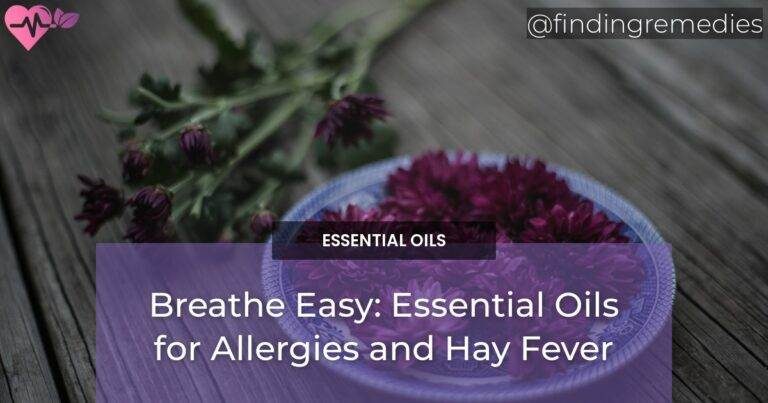Allergies and hay fever can make life miserable for those who suffer from them. The constant sneezing, congestion, and itchy eyes can make it difficult to enjoy the beautiful outdoors during certain seasons. If you’re looking for natural remedies to alleviate your allergy symptoms, essential oils can be a great option. Not only do these oils offer soothing relief, but they also provide many other health benefits. In this comprehensive guide, we will explore the best essential oils for allergies and hay fever, as well as various methods of using aromatherapy for congestion, sneezing, and itchy eyes. We will also discuss how to apply oils topically, the inhalation method for allergy relief, diffusing oils, and even provide some easy-to-follow recipes for seasonal allergy relief.
Best Oils for Allergies
Peppermint Oil
Peppermint oil is known for its refreshing and cooling properties. It can help relieve nasal congestion, clear the sinuses, and reduce inflammation associated with allergies. The menthol content in peppermint oil acts as a natural decongestant and expectorant, making it easier to breathe.
Eucalyptus Oil
Eucalyptus oil is a powerful decongestant that can help open up the airways and relieve sinus congestion. It has anti-inflammatory properties that can reduce swelling and ease breathing difficulties caused by allergies.
ALSO READ
Lavender Oil
Lavender oil is well-known for its calming and soothing effects. It can help alleviate allergy symptoms such as sneezing and itchy eyes. Lavender oil also has anti-inflammatory properties that can reduce nasal inflammation and congestion.
Using Aromatherapy for Congestion, Sneezing, and Itchy Eyes
Inhalation Method
The inhalation method is one of the most effective ways to use essential oils for allergy relief. You can add a few drops of your chosen oil to a bowl of hot water and inhale the steam. This helps to clear the nasal passages and reduce congestion.
ALSO READ
Topical Application
Topical application involves diluting the essential oil with a carrier oil and applying it to the skin. You can massage the oil onto your chest, temples, or behind the ears to relieve congestion and promote relaxation.
Diffusing Method
Diffusing essential oils into the air is another popular method for allergy relief. You can use a diffuser to disperse the oils throughout your home or office. Breathing in the aromatic molecules can help reduce allergy symptoms and create a pleasant environment.
Applying Oils Topically
Dilution Guide
It’s important to properly dilute essential oils before applying them to the skin to avoid any potential irritation. As a general guideline, you can mix 1-2 drops of essential oil with 1 tablespoon of carrier oil, such as coconut oil or sweet almond oil. This dilution ratio ensures safe and effective use.
Targeted Application Techniques
When applying essential oils topically, you can use various techniques to target specific areas. For nasal congestion, you can gently massage diluted oil onto the bridge of your nose. For itchy eyes, you can apply a warm compress infused with diluted oil to provide relief.
Inhalation Method for Allergy Relief
Steam Inhalation
Steam inhalation is a simple yet effective method for relieving congestion and promoting sinus drainage. Add a few drops of your chosen essential oil to a bowl of hot water, cover your head with a towel, and inhale the steam for a few minutes. This can help clear your airways and reduce allergy symptoms.
Direct Inhalation
Direct inhalation involves inhaling the aroma of essential oils directly from the bottle or by placing a few drops on a tissue or cotton ball and holding it near your nose. This method provides quick relief and is convenient for on-the-go use.
Diffusing Oils for Allergies
Choosing a Diffuser
When selecting a diffuser for allergy relief, consider the size of the room and the desired duration of diffusion. Ultrasonic diffusers are popular choices as they create a fine mist and preserve the therapeutic properties of the oils.
Recommended Diffuser Blends
Here are some recommended diffuser blends for allergy relief:
- Blend 1: 3 drops of peppermint oil, 3 drops of eucalyptus oil, and 2 drops of lavender oil.
- Blend 2: 4 drops of lemon oil, 2 drops of tea tree oil, and 2 drops of frankincense oil.
Recipes for Seasonal Allergy Relief
Allergy Relief Roller Blend
Create your own allergy relief roller blend by combining 10 drops of lavender oil, 5 drops of peppermint oil, and 5 drops of eucalyptus oil. Dilute the mixture in 10 ml of carrier oil, such as jojoba oil or fractionated coconut oil. Apply the blend to your temples, wrists, and behind the ears as needed.
Allergy Relief Room Spray
Make a refreshing room spray by mixing 10 drops of lemon oil, 5 drops of lavender oil, and 5 drops of eucalyptus oil with 2 ounces of distilled water. Shake well and spritz the blend around your living space to create an allergy-friendly environment.
DIY Allergy Relief Bath Salts
Relax in a soothing bath infused with allergy relief bath salts. Combine 1 cup of Epsom salt, 10 drops of lavender oil, and 5 drops of chamomile oil. Add the mixture to warm bathwater and soak for 20 minutes to alleviate allergy symptoms and promote relaxation.
By incorporating essential oils into your allergy relief routine, you can experience natural and holistic relief from symptoms such as congestion, sneezing, and itchy eyes. Remember to choose high-quality oils, follow proper dilution guidelines, and select the best application method for your needs. With the power of aromatherapy, allergies and hay fever no longer have to hinder your enjoyment of the great outdoors.

